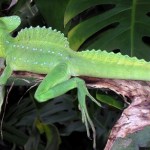herpetology
Here's an interesting contention: until just a few thousand years ago, small crocodilians inhabited the tropical islands of the South Pacific and elsewhere. In fact, judging from recent discoveries, small terrestrial crocodilians were an ordinary component of many tropical island groups, and they presumably still would be, had they not been made extinct by people. This article originally appeared in 2006 on Tet Zoo ver 1, and here it is again...
The first of these animals to be discovered was Mekosuchus inexpectatus from New Caledonia (life restoration shown above), a species that most…
Thanks to Monday's article on the unusual African mosasaur Goronyosaurus, I will admit that I was - quite seriously - considering doing a 'mosasaur week', perhaps even a 'weird mosasaur week'. Alas, I have not had the time. However: brand-new in the journals is Johan Lindgren et al.'s article on the skin of a Plotosaurus bennisoni specimen from the Upper Cretaceous Moreno Formation of central California (Lindgren et al. 2009) [adjacent Plotosaurus life restoration from wikipedia]. The specimen was collected by Anthony Fiorillo in 1993 and belongs to an individual that was about 6.4 m long…
One of my favourite mosasaurs is the unusual Goronyosaurus nigeriensis (Swinton, 1930) from the Maastrichtian of Nigeria and Niger. Mosasaurs are Cretaceous marine lizards, (probably) closely related to gila monsters and kin (the monstersaurians) and monitor lizards and kin (the goannasaurians), and well known for evolving gigantic size (>12 m in some taxa), flippers, and paddle-like tails. Goronyosaurus is cool because, with increasing knowledge, it has become weirder and weirder and weirder...
When William Swinton first described and named Goronyosaurus (as Mosasaurus nigeriensis), it…
It has often been proposed that large reptiles, such as monitor lizards and crocodiles, might have provided the origin for the dragon myths of the world. There might be some truth to this, but the possibility that rather more spectacular reptiles might have played a contributing role is rather more plausible. Confirmation for this hypothesis comes from Hypoblanpied whartoni, described in 2003 from the Pleistocene of France (Freeman 2003).
Freeman (2003) identified seven characters shared by the new taxon and Kuehneosauridae: that's really interesting, because Hall (1991) had proposed much…
Tales of animals that have undergone reconstructive surgery, or end up with prosthetic attachments, always make the news: wheels in place of tortoise legs [example] and that sort of thing. As reported in the Mail online (and other sources) a few days ago, during December 2008 an unfortunate 3-m long, wild American crocodile Crocodylus acutus was run over by a car, in Florida. The animal sustained substantial head injuries: apparently its snout was 'hanging limp' and it was unable to feed. It was captured and taken to the Miami MetroZoo [images below © Barcroft Media].
Here, plans were made…
What fun we've all had, discussing corpses and decomposition. Thanks to all who participated. I'm going away for a couple of days. For no good reason other than that it looks good, find here a slide from a talk I do called 'Britain's changing herpetofauna'. I think it's pretty self-explanatory! The pic of the Marsh frog Pelophylax ridibundus is by Neil Phillips - thanks Neil :)
More snakes, because - thanks to Dave Hone - I have some more pictures to use (and, I'll be honest, at least some of my posts are 'picture-driven'). We've looked previously at the unusual, mostly small, worm-like, burrowing snakes grouped together as the scolecophidians here. In that article, however, I didn't really emphasise the small size of some scolecophidian species. This photo - taken by Dave in Mexico (is that Dino Frey holding the animal?) - makes the point well.
The smallest scolecophidians are Caribbean leptotyphlopids (aka threadsnakes, wormsnakes or slender blindsnakes)…
Anyone who's anyone has heard of the Anaconda. But in fact 'the' Anaconda is the Green anaconda Eunectes murinus. Most zoologically-informed people know that there's a lesser-known, smaller relative of this large species, namely the Yellow or Paraguayan anaconda E. notaeus. Usually only reaching 3-4 m in length (as opposed to 5-9 m for the Green anaconda), the Yellow anaconda [photo here by Dave Hone] typically has a yellowish ground colour, and black spots, patches and streaks decorate its length.
Far less well known is that there are actually a few other anacondas as well. The Dark-…
Yes, more snakes: after yesterday's horned snake article (thanks to everyone who chipped in with ideas and comments) I've decided to stick with snakes for a while. I can knock these articles up in a few minutes, and unfortunately I just don't have time at the moment to finish the backlog of planned and semi-complete articles. And I've had 'snake guilt' for a while now: for a massive tetrapod group encompassing round about 3000 extant species, snakes are still under-represented at Tet Zoo. Those of you who keep track of such things will remember the atractaspidid article, titled Side-stabbing…
Dave Hone (of Archosaur Musings and Ask A Biologist) kindly provided the photo you see here of two captive West African gaboon vipers Bitis rhinoceros (NOT East African gaboon vipers B. gabonica: see comments), and initially I was going to use it in a 'picture of the day' post. One thing led to another and what you're reading is the result. Gaboon vipers, the largest of the African viperids, are among the best known members of the genus Bitis (in which there are about 11 species). Like several other species in the genus, they're stocky, broad-headed snakes of forest floors, but other species…
No time for anything new: too busy desperately trying to make money. So I'd like to bring your attention to Head et al.'s (2009) paper on the amazing new gargantuan snake Titanoboa cerrejonensis from the Palaeocene of Colombia, and also to Ed Yong's fine discussion of the paper at Not Exactly Rocket Science. Surprisingly, perhaps, Titanoboa was not a madtsoiid, but a boid related to modern anacondas and boas. The several specimens represent individuals 13 m long and perhaps 1.1 tons in weight. Staggering. For a review of pre-Titanoboa giant snakes please see Stupidly large snakes, the story…
Welcome to the third, and last, of the rhynchosaur articles. The other two are mandatory reading: part I is a general intro, part II is on jaws and teeth. This time round, we look at the form and function of the postcranial anatomy (well, predominantly at the limbs actually), and also at rhynchosaur phylogeny and at their place in the grand scheme of things [life restoration of Hyperodapedon shown above, from Benton (1983)].
We begin with the forelimb. The rhynchosaur humerus is stout, with large crests for muscle attachment and a wide, flaring distal end. The rest of the forelimb appears…
In the previous rhynchosaur article we introduced these remarkable Triassic reptiles [adjacent Hyperodapedon restoration from wikipedia]. Their amazing, specialised jaws and teeth were mentioned and discussed in passing, but I skimped on the details. Make yourself some strong coffee and be sure you're not sitting in a comfortable chair, as here's where the going gets heavy. It's a story of shearing jaws, expanding tooth fields, and maxillary grooves...
Both the maxilla and dentary in rhynchosaurs possessed more than one row of teeth. You should imagine the occlusal surfaces of these bones as…
Last year Dave Hone (of Archosaurs Musings) and Mike Benton published their analysis of the English rhynchosaur Fodonyx spenceri. Ever one to make promises that I'm unable to fulfil (in the short term, at least), I vowed to cover the group at some stage. Neil Kelley recently reminded us that 2008 was the year in which the blogosphere began to reflect the global Scientific Triassicism movement. Here was the biblical sign I needed to dust off my files and, goddammit, publish on those rhynchosaurs.
Also spurring me into action was the fact that I had to put my much-loved 'The Age of the…
Oh my god. Two years at ScienceBlogs have passed, and Tet Zoo has now been going for three years. It all started on January 21st 2006 when, for no good reason at all, I started a blog over at blogspot.com. Yes, Tet Zoo is three years old. Time to look back at the past year of operation.
For starters, should you want to know more about Tet Zoo's origin and history of operation, read Happy first birthday Tetrapod Zoology part I and part II (both at ver 1), and Happy second birthday part I and part II. Last year, I included a 'what happened in tetrapods during 2007'. I'm not going to do the…
I've pretty much given up on TV. I occasionally watch a few things (The IT Crowd, Doctor Who, QI, Never Mind the Buzzcocks), but mostly it's all shit and I'd be very happy to not have a TV at all. Once in a blue moon, however, there is something really good. On Friday evening (Jan 16th), BBC 2 screened 'The Mountains of the Monsoon' as part of its The Natural World series. This featured wildlife photographer and environmentalist Sandesh Kadur as he travelled about the Western Ghats in quest of wildlife.
The Western Ghats evidently has some awesome wildlife. There are dholes, tigers,…
There just haven't been enough squamates around here lately (well, apart from the anguids). Because I have guilt, here is a good photo of a beautiful animal: a Plumed basilisk Basiliscus plumifrons. Thanks to their striking appearance, basilisks are often featured in books and on TV, but people only ever say the same two things about them: (1) that they have striking display structures like those so obvious here, and (2) that they can run (bipedally) across the surface of water. Yeah yeah, I've heard all that before - tell me something new, puh-lease!
I have to admit that I can't: all the…
At the start of 2008 I promised myself - in fact, I might even have said it on Tet Zoo - that I'd photograph all the Slow-worms Anguis fragilis I see. The bad news is that I only saw four and - of those - one was dead. Nevertheless...
Both individuals you see here (above) were found in the New Forest, within sight of Bournemouth Airport. Neither are fully adult. The male on the left is doing a nice job of coiling round my thumb, and he's showing his grey belly scales in the process. Like other anguid lizards, slow-worms have relatively small belly scales: very different from the transversely…
More musings from the Morocco trip. So, we travelled over the Atlas Mountains and were soon up at the snowline. We joked about seeing lions and bears, but did see a Barbary partridge Alectoris barbara (another first) and a representative of the strikingly blue Blue tit subspecies Cyanistes caeruleus ultramarinus. If you've been keeping up with parid taxonomy you'll know that some workers now regard this blue tit of north-west Africa and the Canaries as a distinct species, the Ultramarine or Afrocanarian tit C. ultramarinus (but note that not all the blue tits of the Canaries belong to this…
From the archives!
One of the most unusual and interesting of amphibians has to be the Olm (Proteus anguinus), an unusual long-bodied cave-dwelling salamander from SE Europe [adjacent image from the Devon Karst Research Society]. Olms were the first specialised cave-dwelling animals (so-called stygobionts or troglobites) to be discovered, they were traditionally identified as dragon larvae by local people, and they remain mysterious and the source of controversy, debate and discovery. I've had a special affinity for olms since seeing them (live) in the former Yugoslavia in 1987, and after a…
















